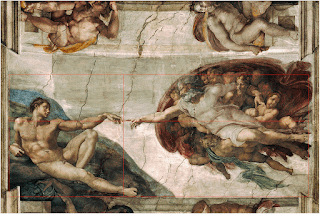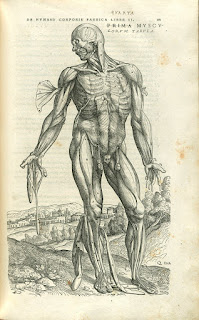Math and Art
If you were to ask the average person their thoughts on the connection between math and art, chances are their answer would say something like they aren’t. People see math as a very left brained logical undertaking while art is seen as a right brain, creative activity. I will admit that I was one of those people who did not really see much of an overlap between the two. But, the more I have thought about and gone through the readings, I can see just how wrong I was. The first thing that really sparked this connection for me was Professor Vesna’s lecture dealing with the golden mean.
 |
| Michelangelo's painting on the sistine chapel with lines superimposed showing the presence of the golden mean |
I gravitated towards this as it is a concept I was already familiar with and is closer to the math/science world that I am more comfortable in. Seeing how often the golden mean was used in art and why was the first time I truly saw the immense overlap between math and art.
From this point, I realized that math was much more intertwined in art than I had previously imagined and I quickly began to notice the overlap more and more. Additionally, I never realized that the artistic community had debates that centered around mathematical concepts such as the fourth dimension and non- Euclidean geometry. But, upon thinking this through, it makes sense that concepts such as these have an impact on art because of the spatial awareness and geometric shapes and principles that are used in paintings and sculptures. While this is a very obvious connected between math and art, most of them are not so blatant. The artist that really sealed the importance of math in art is perhaps one of the more subtle instances of the connection between the two, Jackson Pollock’s work.
 |
| Convergence by Pollock, an example of his typical style of painting |
At first glance, his art appears to be made of splashes and splotches of pain haphazardly thrown onto a canvas. But, like physicist Richard Taylor has shown, upon closer inspection, Pollock’s work contained repeated geometric fractals, suggesting that the paint was not so haphazardly placed on the canvas after all. Even if it’s hidden and hard to see, math plays a more important role in the creation of art than one typically assumes.
 |
| Richard Taylor and a machine he built to mathematically produce paintings in the style of Pollock. |
Vesna, Victoria. “Mathematics, Perspective, Time, Space.” DESMA 9. Lecture.
Henderson, Linda Dalrymple. "The Fourth Dimension and Non-Euclidean Geometry in Modern Art: Conclusion." Leonardo 17.3 (1984): 205-10. Web.
Ouellette, Jennifer. "Pollock's Fractals." Discover Magazine. N.p., 01 Nov. 2001. Web. 15 Apr. 2017. <http://discovermagazine.com/2001/nov/featpollock>.
Meisner, Gary. "Golden Ratio in Art Composition and Design." Goldennumber.net. N.p., 4 May 2014. Web. 15 Apr. 2017. <https://www.goldennumber.net/art-composition-design/>.
Convergence, 1952 by Jackson Pollock. N.p., n.d. Web. 15 Apr. 2017. <http://www.jackson-pollock.org/convergence.jsp>.


This was a very interesting read. I've always despised Jackson Pollock as an abusive drunk with no talent, I had no idea that he really put that much effort into his paintings. I would have never even thought to look at Pollock's work as an example of mathematics. If you'd like to look more into this type of math, look up Pollock's fractals (which might be what Richard Taylor used). Another interesting area where people use the golden mean is in finding and hiring supermodels. That was how I discovered the golden mean. It's amazing to see how so many aesthetic industries revolve around that type of mathematics. What type of science/ math are you in? Why did you take this class?
ReplyDeleteI also really enjoyed your discussion of Jackson Pollock. I have seen many of his paintings in person and have always been fascinated by his work. I know that many people don't think he has any actual talent but it is very cool to see that there is actually a method to his madness. I am going to consider the use of fractuals as I observe modern art in the future.
ReplyDelete